
Our online exhibitions are best viewed on a larger screen.
Tap anywhere to continue.
Please note: Aboriginal and Torres Strait Islander people should be aware that this website may contain images, voices or names of deceased persons in photographs, film, audio recordings or printed material.
Some material may contain terms that reflect authors’ views, or those of the period in which the item was written or recorded, but may not be considered appropriate today. These views are not necessarily the views of AIATSIS. While the information may not reflect current understanding, it is provided in an historical context.

Our online exhibitions are best viewed on a larger screen.
Tap anywhere to continue.
The '65 Freedom Ride exhibition introduces you to the Student Action For Aborigines organisation and explains how students from the University of Sydney drew national and international attention to the poor living conditions of Aboriginal people and the racism that was rife in New South Wales country towns from 12 – 26 February 1965. This event was the beginning of resetting the relationship between Aboriginal people and non-Aboriginal people in contemporary Australia.
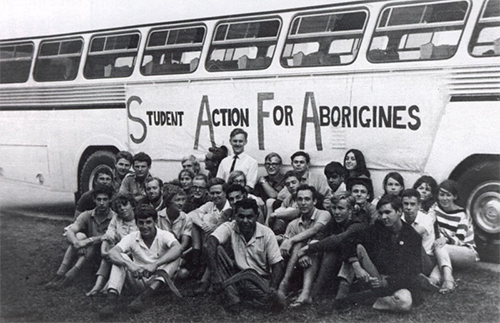
A University of Sydney protest against racial segregation in the United States in 1964 led to the inception of Student Action For Aborigines Organisation (SAFA), and the planning of a fact-finding trip to western New South Wales towns so students could see the conditions of life for Aboriginal people for themselves.
“It was also a reaction to what was being done in America at that time. A number of students gathered together at Sydney University and thought that they might like to see a Freedom Ride eventuate here in Australia. They all put their sixpenceworth in, saying what should happen and what should not happen. No one had any precise ideas about it and we appealed to the Rev. Ted Noffs of the Wayside Chapel.”
Quote from Charles Perkins, A Bastard Like Me.
The Ride included a survey of Aboriginal living conditions, a direct challenge to a ban against Aboriginal ex-servicemen at the Walgett Returned Services League, and a demonstration against local laws barring Aboriginal children from the Moree and Kempsey swimming pools. The group ensured their protests were covered by the media, bringing the issue of racial discrimination to national and international press attention, and stirring public debate about the disadvantage and racism facing Aboriginal people across Australia at the time.
“The Ride was coordinated at the Wayside Chapel. The Chapel was going to be our contact with all the newspapers, television and radio. We did not think there would be much work involved but the Chapel was completely swamped. Ted was involved with the media and political figures and with the parents.”
Quote from Charles Perkins, A Bastard Like Me.
Photograph reproduced with permission of Wendy Watson-Ekstein (nee Golding) and supplied by Ann Curthoys.
At a time when racism was seen by many Australians as issues experienced by other countries such as South Africa or the southern states of the USA, University of Sydney students decided to awaken the community to the reality of Australia’s racism and conditions of life for Aboriginal people in country New South Wales. Charles Perkins, one of only two Aboriginal students at the University at the time, was elected president of the newly-formed Student Action for Aborigines (SAFA).
Meet the students
The students that made up SAFA came from many different existing societies including the Australian Labor Party (ALP), the Newman society, the Jewish Students Union and the Civil Liberties Association. Led by Charles Perkins there were around 35 students that took part in the Freedom Ride. Note: Ages are sometimes approximate, and both age and enrolment in university courses are for February 1965.
29, third year Arts, Arrernte man, born in Alice Springs, former soccer player, Aboriginal activist, President of SAFA. He was the SAFA spokesman during the Freedom Ride.
“The Freedom Ride was probably the greatest and most exciting event I have ever been involved in with Aboriginal affairs”
19, third-year Arts, member of the Labor Club
Ann’s diary forms the narrative of this exhibition and gives us great insight into the day-by-day activities and experiences of the students during the Freedom Ride.
19, third-year Arts, leader of the Fabian Society, breakaway group from the ALP Club
22, part-time third-year Arts, also ABC radio producer, member of the Labor Club
19, third-year Arts, Gumbaynggir man from Nambucca Heads
19, third-year Medicine, member of the Labor Club
19, third-year Science, member of the Labor Club
25, third-year Theology, member of the Liberal Club
18, second-year Arts
19, third-year Arts, member of the Humanist Society
19, third-year Engineering, member of the Labor Club
19, third-year Science, member of the Labor Club
19, third-year Medicine
19, third-year Science, member of the Labor Club
18, second-year Arts
19, third-year Arts
19, third-year Arts, member of the ALP Club
19, second-year Arts
20, third-year Science
University of New England, son of Presbyterian minister from Dubbo
22, fifth-year Medicine, founder of the Sydney University Humanist Society, involved in Campaign for Nuclear Disarmament
20, third-year Arts
18, second-year Medicine, member of the Labor Club
18, second-year Arts, born in Holland, raised in Indonesia
19, third-year Science, member of the Labor Club
19, third-year Arts, member of the ALP Club
20, third-year Arts, member of the Labor Club
22, postgraduate Science
19, third-year Arts
20, fourth-year Arts, in Geography Honours
20, fourth-year Arts, in History Honours
19, third-year Arts, member of Abschol – a committee of the National Union of Australian University Students
19, third-year Arts, member of the Student Christian Movement
17, second-year Arts
Gerry Mason, an older Aboriginal friend of Charles Perkins from Gerard government reserve in South Australia
Bill Pakenham, from Punchbowl, driver of the bus until Grafton
Ernie Albrecht, from Lugarno, driver of the bus from Grafton onwards
The Ride
Home of the Eora people, Friday 12 February
“Well, we hired the bus. We placed a banner along the front and prepared to start off from Sydney. The Rev. Ted said a prayer on the steps for those who like that sort of thing. I was one, I needed that kind of help.”
Quote from Charles Perkins, A Bastard Like Me.
Home of the Wiradjuri people, Saturday 13 February
“Houses of tin, mud floors, very overcrowded, kids had eye diseases, had to cart water (very unhealthy) from river… Jim S and a few others came across some discrimination in a pub. An aboriginal was allowed in only because he was with us. The publican said he only prevented aborigines from coming in "if they were disorderly"… Left Wellington and arrived in Dubbo about 6.30 pm. Had tea, went for a swim, then to the Dubbo hotel. We noticed a sign above the doorway of the halfway hotel - "Aborigines not allowed in the Lounge without the Licensee's permission".” Ann Curthoys' diary from the Freedom Rides

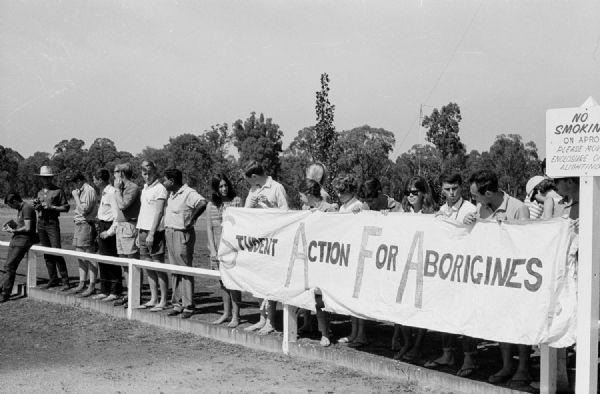
Home of the Wayilwan people, Tuesday 14 February
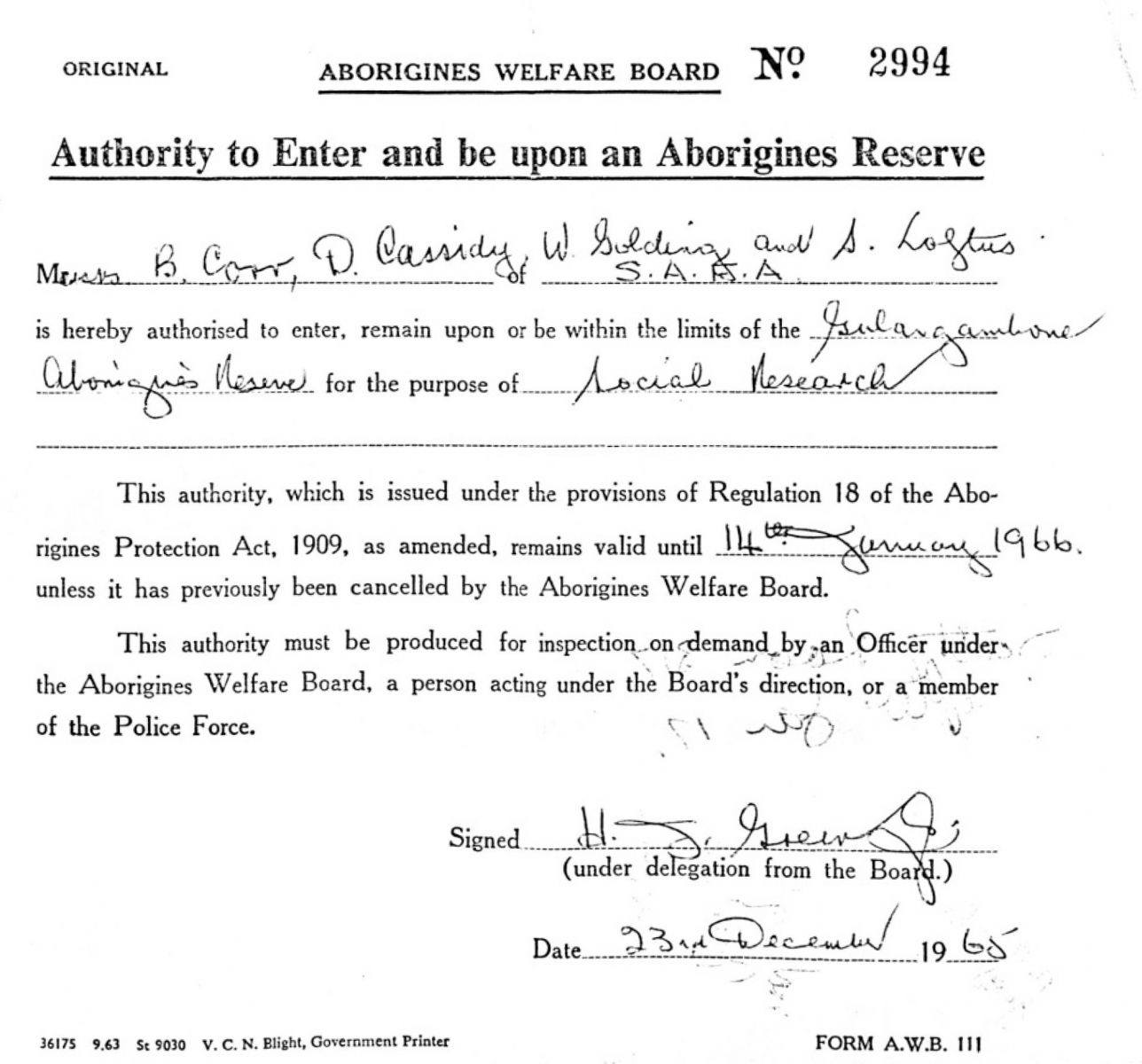

“Heard some radio publicity about us… Only certain aborigines allowed in pub, and aborigines not served in the cafe (the only one)… town jobs for aborigines impossible to get, shearing jobs pay well but are uncertain and seasonal. Welfare board and police very much disliked. Housing very poor.”
Ann Curthoys' diary from the Freedom Rides
On the border between the homes of the Wayilwan and Gamilaraay people, Monday 15 February
“Went to the Namoi River settlement in the morning and did some surveys for a few hours. Most of the people I spoke to very shy and diffident, and said they were quite happy. Conditions very bad - had to use filthy water, tin shacks with mud floors, overcrowded.” Ann Curthoys' diary from the Freedom Rides
“Walgett RSL was famous for entertaining the Aboriginal troops when they came back from World War II. For one day. The next day the majority of the Aboriginal community were banned for good. They were not allowed in any of the hotels and they had to get their beer and were sold cheap plonk through the back windows at three times the price, through sly-grogging operations.”
Quote from Charles Perkins, A Bastard Like Me.
“We took our banners and posters and stood in front of the Walgett RSL. That was in the morning at about eleven o’clock. The heat was tremendous as it was summer-time. We stood there right through until about six o’clock at night, right through in temperatures of one hundred degrees. A couple of the girls fainted and a few of the boys were really exhausted. While we stood there the town came to life like an ant heap. They had never seen anything like it in their lives. People stared. It was a completely new experience, like seeing television for the first time or seeing a moonship fly past their window. Walgett people could not believe it was happening in Walgett. A protest on behalf of the town niggers!”
Quote from Charles Perkins, A Bastard Like Me.
Darce Cassidy recorded the angry conversations and filed a report to the ABC. Captured on tape was the vice-president of the Walgett Returned Service League Club who said he would never allow an Aboriginal to become a member.
“We just stood in a long line outside the RSL holding placards like "Acceptance, Not Segregation" "End Colour Bar" "Bullets did not Discriminate" "Walgett - Australia's Disgrace" "Why Whites Only" "Educate the Whites" and so on. People gathered round, many jeering, many just watching… At lunchtime many heated discussions broke out. Charlie Perkins spoke terrifically and I think most people listened very attentively. As time went on, more and more aborigines joined in the discussions.” Ann Curthoys' diary from the Freedom Rides
“All the members of the RSL had to pass right past us and they read the banners. They either laughed at us or spat at us or on the banners. Some of them got banners and tore them up. Some of the local smarties wanted to bash a few of us up. They said, ‘You’re stirring up trouble. The dirty niggers don’t deserve any better and they are happy how they are.’”
Quote from Charles Perkins, A Bastard Like Me.
“A couple of the Aborigines started to talk to me then. I said, ‘Look, you blokes have to stand up for yourselves. We are willing enough to stand here but you people have to do it from this week on. No one is going to stand up for you but yourselves. If you don’t do it now, your kids will be in the same position as you are when they grow up.” Quote from Charles Perkins, A Bastard Like Me.
“A few blokes from a big group of whites were becoming really hostile… Suddenly a black woman came out of the crowd, followed by a few other Aboriginal women. They called back to most of the vocal white men: ‘Listen! You whites come down to our camp and chase our young girls around at night! You were down there last night. I know you!’ And she called out some names. ‘I saw you last night! It’s no good tellin’ me how good you treat us Aborigines. All you do is chase Aboriginal women in the dark. Why don’t you go back and tell your wives where you’ve been? They’re over there in the crowd! Go on, tell them.’”
Quote from Charles Perkins, A Bastard Like Me.
“The Aboriginal woman told them off right in front of everybody, yelling at one bloke in particular: ‘You there, you’re nothing but a gin jockey!’”
Quote from Charles Perkins, A Bastard Like Me.
“When the Aboriginal woman pointed to a few other white fellows, you should have seen that crowd break up. It was as if someone had thrown a bomb amongst them.”
Quote from Charles Perkins, Bastard Like Me.
“She kept on yelling, ‘Yes, and you! And you! You were there a week ago! You have been going with my sister for two years in the dark! What about tellin’ your wife about her? Tell her about the little baby boy you’ve given her!’ The crowd dispersed in minutes as a result of this Aboriginal woman’s revelations, and Walgett would never be the same again.” Quote from Charles Perkins, A Bastard Like Me.
Outside Walgett Jim Spigelman trained his home movie camera on the hostile convoy of cars which followed the bus out of town at night and ran it off the road.
“About 200 aborigines and some whites came to see us off. We went off quickly, leaving Alex Mills behind because it was obvious there was considerable hostility in the ranks of the pub leavers. About 3 miles out of town a truck tried to push us off the road. There was a stream of about 10 cars following us and we thought they were full of hostile people and so we were all pretty worried. On the third try he scraped the truck along the side of the bus and forced the bus driver to swerve off the road. It tipped slightly but not right over. “
Ann Curthoys' diary from the Freedom Rides
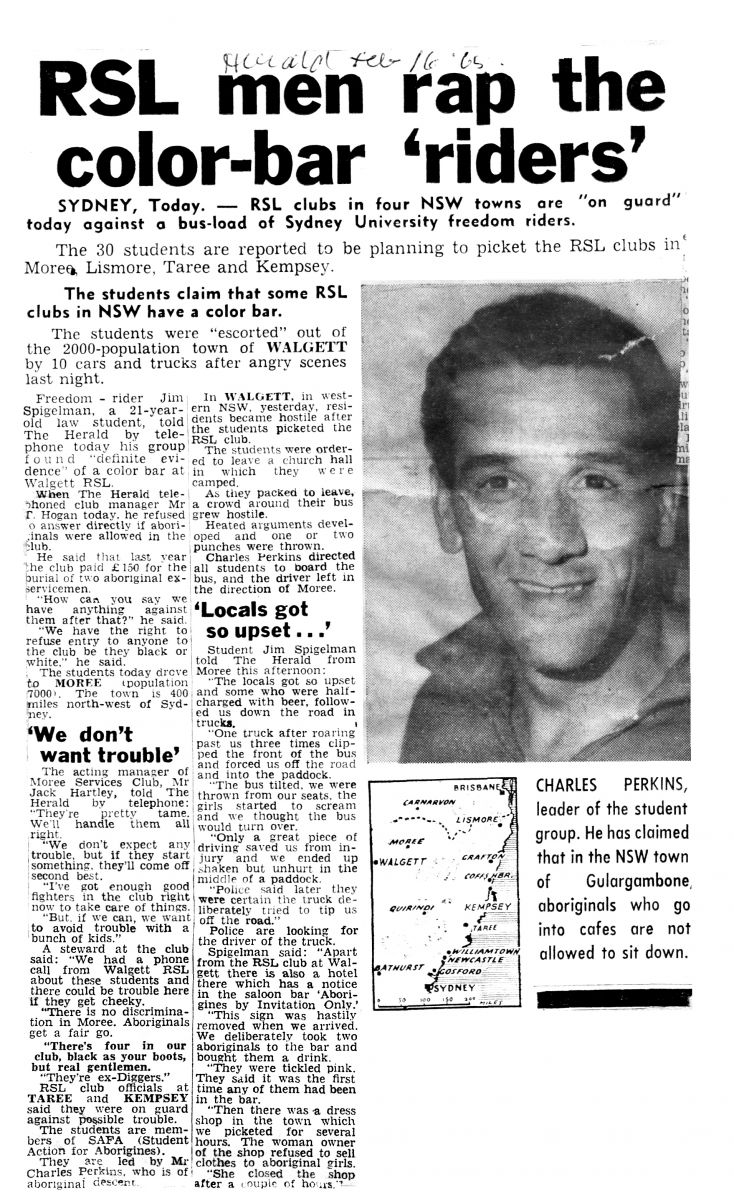
“I yelled, ‘Quick, everybody grab a bottle.’ We were really shaken up and some of the girls were crying. But they grabbed some weapon or other. Jimmy Spigelman and I raced up the front. He had a shoe or some other stupid thing in his hand. I don’t know what he was going to do with that. I had a milk bottle and a Coke bottle and I don’t know what I was going to do with them either.”
Quote from Charles Perkins, Bastard Like Me.
Such evidence was beamed into the living rooms of Australians with the evening news. It exposed an endemic racism. Film footage shocked city viewers, adding to the mounting pressure on the government.
“As for Gerry Mason, our touring Aboriginal, he was white. He turned white that night. When that bus went off the road he went white. He never got back his blackness until the next morning at Collarenebri… Yet from that point on Gerry was very staunch in support of our cause. He stood with us all the way. He held banners at Moree. He came to believe in Aboriginal rights. It was new for him because he came from one of the quietest tribes in South Australia on the River Murray, near Berri.”
Quote from Charles Perkins, Bastard Like Me.
Home of the Gamilaraay people, Tuessday 16 February
“The mission had much better housing etc. than we'd seen anywhere, but there was a manager in control who was apparently very disliked and seemed rather unpleasant.” Ann Curthoys' diary from the Freedom Rides
“We did the picket, but nobody much came around, and we all boiled, it was very hot. Then we went to the swimming pool. The manager refused to let the six aboriginals in and so we held up our posters and signs. After about 25 mins they let the boys in. Then Charlie arrived with a bus load of 21 aboriginal boys and they had to be all let in.”Ann Curthoys' diary from the Freedom Rides
“We went back to the hall, had tea, and then went off to the Memorial Hall for the public meeting we'd arranged. There were over 200 people there and at first the atmosphere was very hostile, with lots of jeering and interjection." Ann Curthoys' diary from the Freedom Rides
“Jim Spigelman spoke first, about who we were and how we came to be there. Then John Powles, on the survey. Then Charlie. The questions were sometimes antagonistic but there were some very sympathetic ones too. Then a Mr Kelly got up and moved that the clause in the statute books about segregation in the swimming pool be removed. This was seconded by Bob Brown, and accepted 88 votes to 10. We were all thrilled to bits." Ann Curthoys' diary from the Freedom Rides


On the border between the homes of the Bigambul and Gamilaraay people, Wednesday 17 February
“We went around and spoke to a lot of people. Many of them told us that the manager had told them not to answer our questions, but they intended to do so anyway.” Ann Curthoys' diary from the Freedom Rides
“The houses were weatherboard and very overcrowded. There was not water on, but the river water was taken to taps in the yard. There was no gas or anything, and no electricity (I think). Very often there weren't windows and doors.”
Ann Curthoys' diary from the Freedom Rides
“We heard some terrible stories such as the fact that the police came in the houses without knocking whenever they liked, to find out who had been drinking. Also they "did what they liked with the women".” Ann Curthoys' diary from the Freedom Rides

Home of the Marbal people, Thursday 18 February
“There we heard from Bob Brown that they day after we left Moree (yesterday) about 60 aboriginal children tried to get in the pool after school. Up to 5.30 about 30 were allowed in, some with Bob Brown, others not. At 5.30 pm the manager refused to allow any more aborigines in and at 6pm the baths were closed (usually they stay open till 8pm). The baths opened again at 7pm and soon after this the mayor stated that the segregationalist statute of June 6th 1955 would be enforced.” - Ann Curthoys' diary from the Freedom Rides
“We decided, after much heated discussion, to go straight to Inverell, thus leaving out Tabulam... From there we would go straight to Moree and take strong action of some kind, such as a 24hr picket or something. The decision was unanimous.” - Ann Curthoys' diary from the Freedom Rides
Home of the Gamilaraay people, Friday 19 & Saturday 20 February
“On the radio we heard that aboriginal children had been demonstrating outside the Moree baths for the last two afternoons, which was terrific news. All of us are very determined that we are doing the right thing despite the mayor's warning over the radio that our return would cause harm.”
Ann Curthoys' diary from the Freedom Rides
“We went down to the mission with a few of the students in the bus and we explained to some older Aborigines. Then we went to one particular road in town where a lot of Aborigines live. They were the ‘upper-class adult Aborigines and they did not want anything to do with us at all…So we went back to speak to the young Aboriginal people on the mission: ‘Yeah we’ll support ya!’” Quote from Charles Perkins, A Bastard Like Me.
“Charlie started talking to the crowd, but there was a lot of hissing and booing. Then he went to the front of the line and when he refused to move was grabbed and taken away from the line.”
Ann Curthoy’s diary from the Freedom Rides
“When we got down to the pool I said, ‘I want a ticket for myself and these ten Aboriginal kids behind me. Here’s the money.’ ‘Sorry, darkies not allowed in,’ replied the baths manager. The manager was a real tough looking bloke too. He frightened me. We decided to block up the gate: ‘Nobody gets through unless we get through with all the Aboriginal kids!’ And the crowd came, hundreds of them. They were pressing about twenty deep around the gate.'” Quote from Charles Perkins, A Bastard Like Me.
“Angry discussion broke out everywhere. I have never met such hostile, hate-filled people. The hostility seemed to be directed at us as university student intruders rather than to the aborigines.” Ann Curthoys' diary from the Freedom Rides
“The mayor ordered the police to have us removed from the gate entrance. They took hold of my arm and the struggle started. There was a lot of pushing and shoving and spitting. Rotten tomatoes, fruit and eggs began to fly, then the stones were coming over and bottles too.” Quote from Charles Perkins, A Bastard Like Me.
“The aboriginal children told us that they had been called "scabby black ------ niggers". One child had been knocked down. The poor kids were very frightened.” Ann Curthoys' diary from the Freedom Rides
“The mob from the hotel across the road decided that they were going to show these university students and niggers and black so-and-so’s whose town this was. They came over and did most of the kicking, throwing and punching, and the spitting.” Quote from Charles Perkins, A Bastard Like Me.
“In all the scuffling Darcy with his tape was knocked down by a man John B and I had been arguing with. Jim S was punched and knocked down in the course of an argument. He lay quite dazed on the ground for a few seconds.” Ann Curthoys' diary from the Freedom Rides
“The police came up and warned us that if we stayed the violence would get much worse. We decided to stay, continuing to insist on being allowed to enter the pool with the aboriginal children. Tomatoes and eggs continued to be thrown.” Ann Curthoys' diary from the Freedom Rides
“Then - breakthrough! The mayor came up to us and stated categorically that he would be prepared to sign a motion to rescind the 1955 statute we were protesting against, and would get two other aldermen to co-sign it.” Ann Curthoys' diary from the Freedom Rides
“They let the kids in for a swim and we went in with them. We had broken the ban! Everybody came in! We saw the kids into the pool first and we had a swim with them. The Aboriginal kids had broken the ban for the first time in the history of Moree.” Quote from Charles Perkins, A Bastard Like Me.
“The police then asked us to leave because the crowd was becoming uglier and there were fights breaking out. It was getting dark too. A lot of the blokes were really set on giving us a going-over. The police called in more reinforcements and formed a solid line of police to the bus. It was not very wide and we had to go through it… I was literally covered in spit.” Quote from Charles Perkins, A Bastard Like Me.
“We walked single file though the crowd who threw eggs, tomatoes, stones, and spat at us. We bundled into the bus and closed all the windows. Eggs and tomatoes were still thrown. Then we all moved off. About 30 cars tried to follow us but the police stopped them.” Ann Curthoys' diary from the Freedom Rides
“We got first place in the 11 o'clock news.” Ann Curthoys' diary from the Freedom Rides


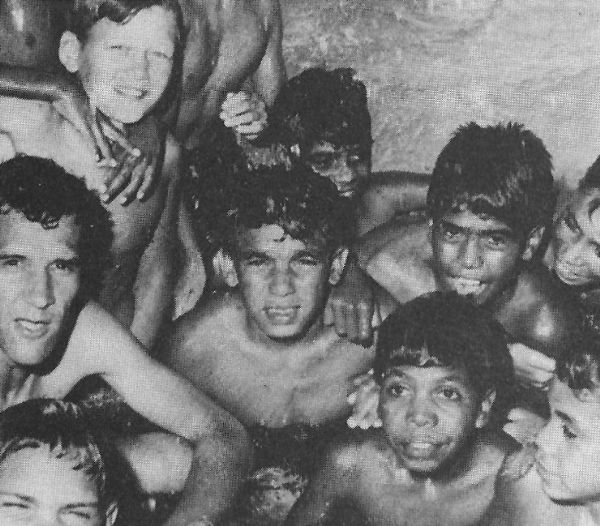
On the border between the Bundjalung and Gumbaynggir people, Sunday 21 February
“We heard a tape prepared by a Mr Miles, from the ABC. It described the conditions of aborigines on the far north coast, really exposed the complexities of the problem and suggested concrete solutions. There were many recordings of aborigines expressing their views. The tape was prepared two years ago but had never been used - it was too hard-hitting for the ABC.” Ann Curthoys' diary from the Freedom Rides

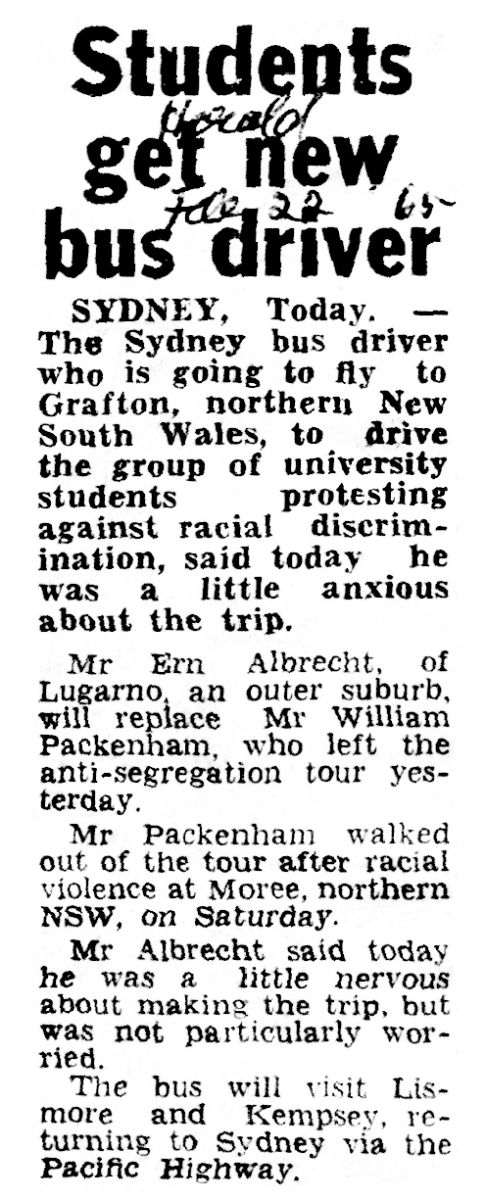
Home of the Bundjalung people, Tuesday 22 February
“Cabbage Tree Island was very interesting but the reserve was really very much like any other reserve. The coop. shop was OK and so were some of the houses, but others did not have water or electricity. The manager seemed to be a real bastard.” Ann Curthoys' diary from the Freedom Rides
Home of the Gumbaynggir people, Tuesday 23 February
“We'd hardly arrived when this woman, the president or secretary or something of a local Aborigines Welfare Committee, assured us there was no discrimination in Bowraville, and told us all about how wonderful her committee was.”Ann Curthoys' diary from the Freedom Rides
“A group of us went out to the reserve which was about one and a half miles out of town. It was controlled by the Welfare Board but didn't have a manager… The conditions were very bad. The houses were weatherboard, very run down, and hadn't been looked after for 15 years (the houses were 26 years old). They were extremely overcrowded.” Ann Curthoys' diary from the Freedom Rides
“The general picture we got from talking to the people on the reserve was one of extreme lack of job opportunity… The discrimination in the town was absolutely shocking - by far the worst we'd encountered. We learnt there was a partition in the picture theatre separating the aborigines from the whites. The aborigines had to buy their tickets separately and could only enter the theatre after the picture had started.” Ann Curthoys' diary from the Freedom Rides
“We learnt of a number of segregated pubs and cafes, and of instances of segregation in the school about 6 years earlier. The two populations were almost completely separate. At first we weren't sure where to start - the town was just so bad. We thought the press could blow up a big story about it, but they refused, obviously instigating us to put on a demonstration.” Ann Curthoys' diary from the Freedom Rides
“We decided to first go up to the manager of the picture theatre, who had previously told Hall that he would let no aborigines in the back of the picture hall, including Charlie Perkins. We went up to see him but he refused to answer the door. The press got a photo of him opening the door slightly and shut it.” Ann Curthoys' diary from the Freedom Rides
Home of the Dhanggati people, Wednesday 24 February
“The general picture in Kempsey re discrimination was that everything was fair (a cafe here and a pub there excepted), but the segregation of the swimming pool was the most outstanding thing.” Ann Curthoys' diary from the Freedom Rides
“We took about 10-15 kids with us to the swimming pool. They weren't allowed in and neither were Charlie or Gary. Absolutely blatant.” Ann Curthoys' diary from the Freedom Rides
“Charlie was very emphatic about the success of it because of the publicity, but most of the rest of us thought it an absolute flop because we had failed to force the issue within Kempsey itself. We all realised Kempsey had ignored us, which was precisely what we didn't want.” Ann Curthoys' diary from the Freedom Rides
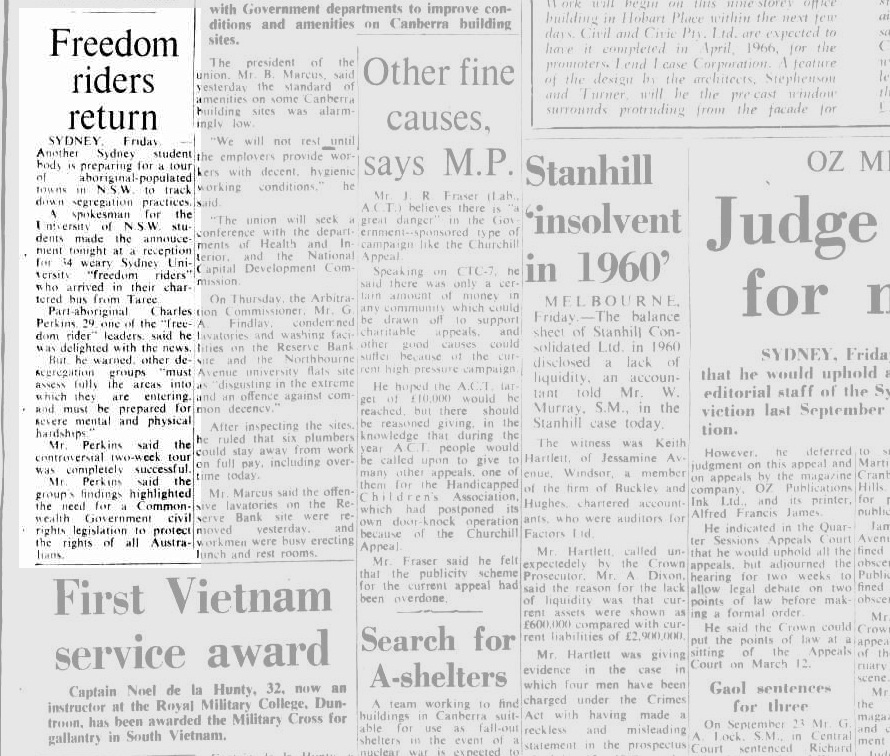
Overseas newspapers such as the New York Times reported on the Freedom Riders and their reception in New South Wales country towns.
Charles Perkins reported these events to a crowd of 200 attending the 1965 Federal Council for the Advancement of Aborigines and Torres Strait Islanders (FCAATSI) conference in Canberra. 'The problem is out in the open now', he told them, and suggested necessary follow-up work such as the building of relationships with local Aboriginal groups, improved services and access to education for Aboriginal residents in western New South Wales towns. Conference goers heard that one positive result of the students' activities was that the NSW Aborigines Welfare Board publicly announced that it would spend sixty-five thousand pounds on housing in Moree.
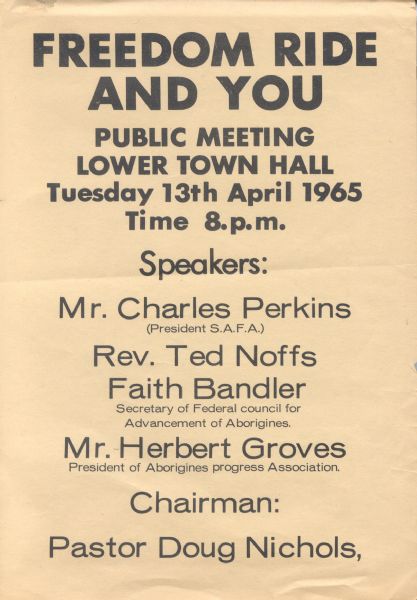
Later in the year Harry Hall, president of the Walgett Aborigines' Progessive Association, appealed to Perkins and other Aboriginal activists to return to Walgett to assist in the fight against the colour bar applied at the Oasis Hotel. Perkins and others did return to help in Walgett. The Freedom Ride through New South Wales towns and the publicity it gained raised consciousness of racial discrimination in Australia and strengthened the campaigns to bring about a greater equality and recognition which followed.
SAFA engaged in some further visits to country towns later in the year but, by the end of 1966, it was finished as a political force.
Want to find out more about the Freedom Ride?
AIATSIS acknowledges the traditional owners of country throughout Australia and their continuing connection to land, culture and community.
We pay our respects to elders past and present.